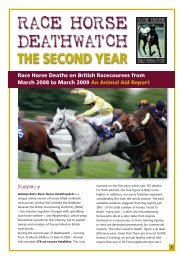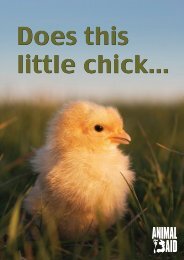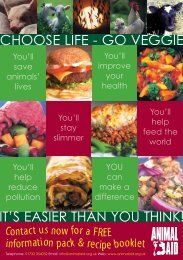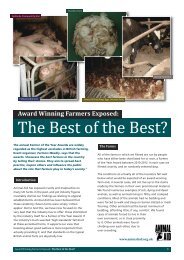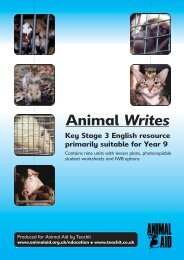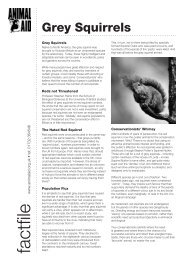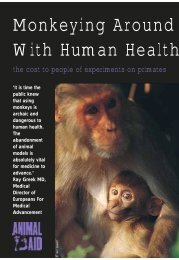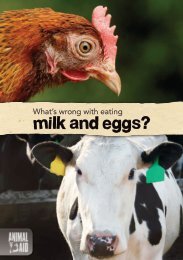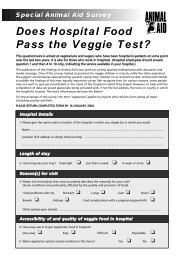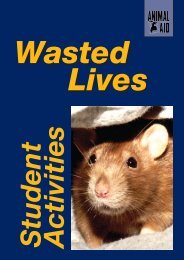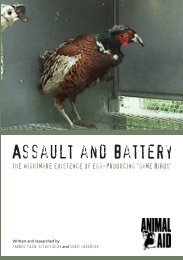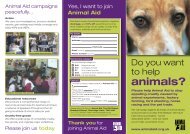Your guide to going veggie or vegan - Animal Aid
Your guide to going veggie or vegan - Animal Aid
Your guide to going veggie or vegan - Animal Aid
You also want an ePaper? Increase the reach of your titles
YUMPU automatically turns print PDFs into web optimized ePapers that Google loves.
Welcome <strong>to</strong> <strong>Animal</strong> <strong>Aid</strong>’s <strong>guide</strong> <strong>to</strong> animal-free<br />
shopping, cooking and eating.<br />
.................................... Why Veggie?<br />
Going <strong>veggie</strong> means that you will be living a m<strong>or</strong>e compassionate lifestyle, given that<br />
the average meat-eater consumes thousands of animals in his <strong>or</strong> her lifetime. It’s also<br />
the healthy choice. A well-balanced meat-free diet is low in saturated fat and cholesterol<br />
and reduces the risk of you suffering from diet-related illnesses including obesity, heart<br />
disease, diabetes and some cancers. Going <strong>veggie</strong> is also better f<strong>or</strong> the planet as the<br />
farming and slaughtering of animals is now recognised <strong>to</strong> be a significant contribu<strong>to</strong>r <strong>to</strong><br />
<strong>to</strong>day’s greatest environmental problems.<br />
.................................... Why Vegan?<br />
A <strong>vegan</strong> diet contains no animal products at all – including milk and eggs – and so<br />
<strong>vegan</strong>s do not contribute <strong>to</strong> the deaths of the millions of animals caused by the egg and<br />
dairy industries (see pages 30 & 31). A balanced plant-based diet is healthy and contains<br />
all the nutrients that the body needs. It is also the best diet <strong>to</strong> protect the planet. Being<br />
vegetarian makes a positive difference, but if you can be <strong>vegan</strong>, the benefits are greater<br />
still.<br />
With supermarkets and high street shops s<strong>to</strong>cking a wide range of <strong>veggie</strong> and <strong>vegan</strong><br />
foods, it really couldn’t be easier.<br />
There are non-animal versions of almost every food you can think of,<br />
and a huge variety of new flavours and interesting foods <strong>to</strong> discover.<br />
So expl<strong>or</strong>e, experiment, enrich your life and enjoy!<br />
Scramble on <strong>to</strong>ast<br />
..........................................................<br />
Ingredients Serves 2<br />
• 250g plain <strong>to</strong>fu<br />
• 1 clove garlic – peeled and crushed<br />
• 1 tsp turmeric<br />
• 1 tsp mixed herbs<br />
• Freshly ground black pepper<br />
• Tabasco sauce – a few splashes<br />
• 2 tbsp vegetable oil <strong>to</strong> fry<br />
• 2-4 slices of bread f<strong>or</strong> <strong>to</strong>asting<br />
..........................................................<br />
Recipes<br />
Method<br />
Mash the <strong>to</strong>fu, add all the other ingredients and<br />
mix in. Put oil in a saucepan, heat, add the <strong>to</strong>fu mix<br />
and stir until heated through, approx 3 mins.<br />
Serve on <strong>to</strong>ast.<br />
2 3<br />
Pho<strong>to</strong>: Sarah Tildesley
Pho<strong>to</strong>: cleangreensimple.com<br />
Tofu quiche<br />
.......................................................<br />
Ingredients Serves 4<br />
• 1 roll of Jus-Rol sh<strong>or</strong>tcrust pastry <strong>or</strong><br />
• 255g plain flour and<br />
• 130g dairy-free margarine<br />
• Olive oil f<strong>or</strong> frying<br />
• 1 medium onion – peeled and chopped<br />
• 1 red pepper – sliced after pith and<br />
seeds removed<br />
• 1 medium courgette <strong>or</strong> broccoli head -<br />
chopped (<strong>or</strong> your choice of veg)<br />
• 3-4 cloves garlic – peeled and crushed<br />
• Salt and pepper <strong>to</strong> taste<br />
• 1 x 250g plain <strong>to</strong>fu <strong>or</strong> 1 x 250g smoked<br />
<strong>to</strong>fu<br />
• Splash of unsweetened soya milk<br />
• 1/2 packet of soya cheese<br />
.......................................................<br />
Method<br />
Preheat oven <strong>to</strong> 200C / 375F / gas 5<br />
Quiche dish approx 25x30cm<br />
Pastry: If not using ready-made pastry, make it from<br />
scratch by rubbing the margarine in<strong>to</strong> the flour until<br />
it resembles fine breadcrumbs. Add enough water <strong>to</strong><br />
make a dough which is soft, but not sticky. Roll out on a<br />
floured board <strong>to</strong> size. Press pastry in<strong>to</strong> the quiche dish.<br />
Filling: Fry the onions lightly f<strong>or</strong> a few minutes. Add<br />
the vegetables and garlic and fry until they begin <strong>to</strong><br />
soften. Take off heat and set aside. Season.<br />
Break up the <strong>to</strong>fu in<strong>to</strong> a blender and grate the cheese<br />
<strong>to</strong> taste. Blend <strong>to</strong>gether, gradually adding milk until<br />
it f<strong>or</strong>ms a paste. Add this mixture <strong>to</strong> the cooked<br />
vegetables. Place in<strong>to</strong> the quiche dish. Bake f<strong>or</strong> 40-50<br />
minutes <strong>or</strong> until browned on <strong>to</strong>p. Allow <strong>to</strong> cool/set f<strong>or</strong><br />
a sh<strong>or</strong>t while bef<strong>or</strong>e slicing and serving with a salad.<br />
....................................................<br />
Ingredients<br />
• 1 cup plain white flour<br />
• Just over 1 cup soya milk<br />
• Pinch of salt<br />
• Olive oil f<strong>or</strong> frying<br />
....................................................<br />
Pho<strong>to</strong>: <strong>vegan</strong> yum yum<br />
Method<br />
Blend the soya milk, salt and flour and check the<br />
consistency by dipping a spoon in. The batter should<br />
evenly coat the spoon.<br />
Put a teaspoon of oil in a heavy-bot<strong>to</strong>med frying<br />
pan and tilt <strong>to</strong> coat evenly. Heat oil on a medium<br />
high flame until it begins <strong>to</strong> smoke. Pour a quarter<br />
of the batter in and tilt and rotate so that the batter<br />
has covered the bot<strong>to</strong>m and crept up the sides of the<br />
pan just a tiny bit. When it looks like the <strong>to</strong>p of the<br />
crêpe has set and the sides are beginning <strong>to</strong> brown,<br />
flip over using a spatula and cook the other side f<strong>or</strong><br />
just under a minute.<br />
Place your choice of vegetable filling on one side and<br />
roll the crêpe. You could also cover the filled crêpes<br />
with a ‘cheese’ sauce (see page 7).<br />
Adapted from The Breakfast Scoffer by Ronny, which is<br />
available from <strong>Animal</strong> <strong>Aid</strong>.<br />
Savoury crepes<br />
4 5<br />
v
6<br />
Pho<strong>to</strong>: Sarah Tildesley<br />
..........................................................<br />
Ingredients Serves 3 <strong>to</strong> 4<br />
• 1 tbsp olive oil f<strong>or</strong> frying<br />
• 2 onions – peeled and chopped<br />
• 2-4 cloves garlic – peeled and crushed<br />
• Freshly ground black pepper<br />
• 1 tin of chopped <strong>to</strong>ma<strong>to</strong>es<br />
• 3 tbsp <strong>to</strong>ma<strong>to</strong> purée<br />
• 2 tsp yeast extract<br />
• 1 tbsp herbs f<strong>or</strong> seasoning<br />
• 2 tsp bouillon s<strong>to</strong>ck powder dissolved in<br />
600ml of hot water<br />
• 300g of frozen soya mince<br />
• Lasagne sheets<br />
White sauce<br />
• 60g dairy-free margarine<br />
• 60g plain flour<br />
• 3/4 litre unsweetened soya milk<br />
• 1 tsp English mustard<br />
• 120g melting soya cheese (e.g. Redwood’s<br />
melting cheezly) – finely grated<br />
• Plus a little extra ‘cheese’ f<strong>or</strong> grating over<br />
the <strong>to</strong>p<br />
Lasagne<br />
• 4 tbsp Engevita (Marigold’s nutritional yeast<br />
flakes, available from any good health food<br />
shop) (optional – f<strong>or</strong> extra ‘cheese’ taste)<br />
• Freshly ground black pepper<br />
..........................................................<br />
Method<br />
Preheat oven <strong>to</strong> 190C / 375F / gas 5<br />
In a large pan, heat 1 tbsp oil and fry onions until soft.<br />
Add garlic, black pepper, chopped <strong>to</strong>ma<strong>to</strong>es, <strong>to</strong>ma<strong>to</strong><br />
purée, yeast extract and herbs. Then make s<strong>to</strong>ck and<br />
pour in<strong>to</strong> pan, followed by soya mince. Cook until the<br />
mince has abs<strong>or</strong>bed most of the liquid and then turn off<br />
heat.<br />
Meanwhile, melt the margarine in a saucepan. Once<br />
melted, stir in flour and cook f<strong>or</strong> a further minute, stirring<br />
constantly so as not <strong>to</strong> burn. Then add the soya milk and<br />
mustard <strong>to</strong> the flour mixture slowly and stir constantly.<br />
Stir in the ‘cheese’ and bring <strong>to</strong> the boil. Then simmer f<strong>or</strong><br />
a few minutes until a nice thick ‘custard’ is made, stirring<br />
frequently. Taste it, season with pepper and add the<br />
Engevita f<strong>or</strong> added ‘cheese’ taste.<br />
In a deepish oven dish put a layer of soya mince, then a<br />
layer of lasagne sheets over this, then a layer of ‘cheese’<br />
sauce. Repeat the layers ending with the ‘cheese’ sauce.<br />
Sprinkle with grated ‘cheese’.<br />
Cook in oven f<strong>or</strong> 40 mins <strong>or</strong> until brown. Check a knife<br />
will cut easily through. Let the dish stand f<strong>or</strong> 5 <strong>to</strong> 10<br />
minutes bef<strong>or</strong>e eating.<br />
Serve with green vegetables <strong>or</strong> garlic bread and salad.<br />
If you can’t use all the mince mixture in the lasagne dish<br />
because it is not deep enough, use the remainder as a<br />
bolognaise sauce with spaghetti the next day <strong>or</strong> as the<br />
base f<strong>or</strong> a shepherd’s pie.<br />
7
Pho<strong>to</strong>: flavourpho<strong>to</strong>s<br />
Mushroom stroganoff<br />
.........................................................<br />
Ingredients Serves 4<br />
• Dairy-free margarine f<strong>or</strong> frying<br />
• 2 medium onions – peeled and chopped<br />
• 3 large cloves garlic – peeled and crushed<br />
• 500g mushrooms – sliced<br />
• 150ml <strong>vegan</strong> white wine*<br />
• 1 heaped tbsp c<strong>or</strong>nflour<br />
• 250ml soya cream<br />
• Lemon juice<br />
• Freshly ground black pepper<br />
.........................................................<br />
Method<br />
Fry the onions and garlic in a little margarine until<br />
soft. Add the mushrooms and cook through. Once<br />
the mushrooms are cooked, add the wine and simmer<br />
until it has evap<strong>or</strong>ated.<br />
Mix 3 tablespoons of water with the c<strong>or</strong>nflour <strong>to</strong><br />
make a paste and then add this and the cream<br />
<strong>to</strong> the vegetables. Simmer f<strong>or</strong> 15 minutes. Add a<br />
good squeeze of lemon juice and season with black<br />
pepper.<br />
Serve with rice.<br />
* See pages 20 - 21<br />
........................................................<br />
Ingredients Serves 2 <strong>to</strong> 4<br />
• 2 tbsp olive oil f<strong>or</strong> frying<br />
• 1 onion – peeled and sliced<br />
• 1 courgette <strong>or</strong> carrot – sliced (optional)<br />
• 1/2 tsp smoked paprika<br />
• 1 x 400g tin chopped <strong>to</strong>ma<strong>to</strong>es <strong>or</strong> 1/2 jar<br />
passata<br />
• 1 x 400g tin white beans e.g. butter beans<br />
<strong>or</strong> cannelini<br />
• 4 <strong>veggie</strong> sausages e.g. Redwoods - sliced<br />
• 1/2 tsp vegetable bouillon powder<br />
• Chopped parsley <strong>to</strong> taste<br />
• Freshly ground black pepper <strong>to</strong> taste<br />
........................................................<br />
Method<br />
Heat the oil in a pot and sauté the onion and<br />
courgette until soft. Add the paprika and stir briefly.<br />
Then add the <strong>to</strong>ma<strong>to</strong>es, beans and sausages. Add<br />
the bouillon powder and stir. Add water if needed.<br />
Cook f<strong>or</strong> 10 minutes until the liquid is reduced.<br />
Add fresh parsley and black pepper as required.<br />
Serve with jacket pota<strong>to</strong> <strong>or</strong> rice.<br />
Created by Liz Hughes -- www.ourlizzy.com<br />
Sausage and bean casserole<br />
8 Pho<strong>to</strong>: Miikka H<br />
9
10<br />
..........................................................<br />
Ingredients Serves 4<br />
Pota<strong>to</strong> Wedges<br />
• 3 large sweet pota<strong>to</strong>es – peeled<br />
• 1 tbsp olive oil<br />
• Sprig of rosemary – taken off stalk<br />
• Freshly ground black pepper<br />
Burgers<br />
• 1 clove garlic – peeled and chopped<br />
• 2.5cm (1 inch) piece of fresh ginger –<br />
peeled and grated<br />
• 1 small red chilli<br />
• Handful fresh c<strong>or</strong>iander leaves<br />
• 1 small lemongrass stalk – <strong>to</strong>pped and<br />
tailed, then smashed under the handle of a<br />
knife and chopped<br />
• 1 lime – juiced<br />
• 1 tbsp soy sauce<br />
• 2 x 400g tin butter beans – drained and<br />
rinsed<br />
Thai bean burger & Sweet pota<strong>to</strong> wedges<br />
• 6-8 spring onions – chopped<br />
• 100g plain flour<br />
• Freshly ground black pepper<br />
• Olive oil f<strong>or</strong> frying<br />
..........................................................<br />
Method<br />
Preheat oven <strong>to</strong> 180C / 350F / gas 4<br />
Cut the pota<strong>to</strong>es in<strong>to</strong> wedges and place on an oiled<br />
baking sheet. Turn in the oil. Sprinkle with rosemary<br />
and pepper. Bake f<strong>or</strong> approx 20-25 minutes.<br />
In a blender/process<strong>or</strong>, put the garlic, ginger, chilli,<br />
c<strong>or</strong>iander, smashed and chopped lemongrass, lime<br />
juice and soy sauce and whiz until a smooth paste.<br />
(If you don’t have a blender/process<strong>or</strong>, chop the<br />
ingredients very, very finely.) Roughly mash the butter<br />
beans, add the chopped spring onions and paste, mix<br />
well and mould in<strong>to</strong> burger-shaped patties.<br />
Put the flour on a plate and season with freshly ground<br />
black pepper. Gently turn the patties in the flour <strong>to</strong> coat.<br />
In a large frying pan, add the oil and fry the burgers on a<br />
high heat f<strong>or</strong> a few minutes each side.<br />
Serve with a fresh salad.<br />
11
12<br />
Pho<strong>to</strong>: flavourpho<strong>to</strong>s<br />
..........................................................<br />
Ingredients Serves 8 <strong>to</strong> 10<br />
Sponge<br />
• 180ml water<br />
• 175g brown sugar<br />
• 100ml sunflower oil (<strong>or</strong> other light<br />
vegetable oil)<br />
Chocolate <strong>or</strong>ange sponge cake<br />
• 300g white self-raising flour<br />
• 2 tsp baking powder<br />
• 2 heaped tbsp cocoa powder<br />
Chocolate <strong>or</strong>ange icing<br />
• 115g dairy-free margarine<br />
• 170g icing sugar – sifted<br />
• 60g cocoa powder – sifted<br />
• 1 small <strong>or</strong>ange – finely scrape zest and mix<br />
with the juice<br />
..........................................................<br />
Method<br />
Preheat oven <strong>to</strong> 180C / 350F / gas 4<br />
Grease two 18cm / 7inch cake tins with dairy-free<br />
margarine.<br />
Sponge Cake<br />
Mix the water, sugar and oil in a pan and heat gently,<br />
stirring until sugar dissolves. Leave <strong>to</strong> cool and then<br />
add dry ingredients, folding mixture <strong>to</strong>gether carefully<br />
– rather than beating it – until well mixed. Pour in<strong>to</strong> tins<br />
and bake f<strong>or</strong> approx 30 mins. Leave <strong>to</strong> cool f<strong>or</strong> only 2<br />
<strong>or</strong> 3 mins. Gently go around the edge with a blunt knife<br />
and turn out on<strong>to</strong> a wire rack. Leave <strong>to</strong> cool.<br />
Icing<br />
In a bowl, beat the margarine until soft, then gradually<br />
add the icing sugar and cocoa, beating until smooth.<br />
Add only a little of the <strong>or</strong>ange juice at a time – you’ll<br />
need far less liquid than you think – and mix th<strong>or</strong>oughly.<br />
Spread half the icing on<strong>to</strong> one cake and put the other<br />
cake on <strong>to</strong>p. Coat the <strong>to</strong>p of the finished cake with the<br />
remaining icing.<br />
13
14<br />
Pho<strong>to</strong>: Sarah Tildesley<br />
..........................................................<br />
Ingredients Serves 6 <strong>to</strong> 8<br />
Base<br />
• 75g dairy-free margarine<br />
• 340g <strong>vegan</strong> digestive biscuits<br />
Cheesecake mixture<br />
• 3 lemons – zest and juice<br />
• 430g plain <strong>to</strong>fu<br />
• 95ml soya milk<br />
• 95ml sunflower oil<br />
• 95g soft brown sugar<br />
• 1 tbsp vanilla essence<br />
Topping<br />
• 1 kiwi - sliced<br />
Strawberry and kiwi cheesecake<br />
• 1 85g packet vegetarian strawberry jelly<br />
crystals (e.g. Just Wholefoods)<br />
..........................................................<br />
Method<br />
Preheat oven <strong>to</strong> 160C / 325F / gas 3<br />
Grease a loose bot<strong>to</strong>med, deep, 20cm / 8inch cake tin<br />
with dairy-free margarine.<br />
Cheesecake<br />
Crush the digestives until they resemble fine<br />
breadcrumbs. Melt the margarine gently in a saucepan,<br />
pour in the biscuit crumbs and mix well. Press the<br />
biscuit-mix firmly in<strong>to</strong> the cake tin until about 1cm<br />
deep. Finely grate the lemon rinds and put in<strong>to</strong> a<br />
blender along with the squeezed lemon juice. Add all<br />
the other mixture ingredients and blend <strong>to</strong>gether until<br />
the mixture is smooth and creamy. Pour the blended<br />
mixture on<strong>to</strong> the base, smooth the <strong>to</strong>p and place in the<br />
oven f<strong>or</strong> one hour <strong>or</strong> until the <strong>to</strong>p turns a rich golden<br />
brown.<br />
Topping<br />
Allow the cheesecake <strong>to</strong> cool. Follow the instructions<br />
on the jelly packet. Slice the kiwi and arrange on <strong>to</strong>p<br />
of the cheesecake. Then pour on hot jelly. Leave <strong>to</strong> cool<br />
and then place in the fridge <strong>to</strong> set.<br />
15
Pho<strong>to</strong>: N<strong>or</strong>a Kuby<br />
16<br />
Chocolate chip cookies<br />
......................................................<br />
Ingredients Makes 24<br />
• 225g dairy-free margarine<br />
• 250g sugar<br />
• 1 tbsp molasses<br />
• 1 tsp vanilla extract<br />
• 500g plain flour<br />
• 1 tbsp soya flour<br />
• 1 tsp bicarbonate of soda<br />
• 1 tsp salt<br />
• 100ml soya milk<br />
• 150-200g plain chocolate chips<br />
......................................................<br />
Method<br />
Preheat oven <strong>to</strong> 190C / 375F / gas 5<br />
Cream the margarine, sugar, molasses and vanilla with<br />
an electric whisk (<strong>or</strong> a wooden spoon).<br />
Sift in the flours, bicarbonate and salt. Whisk until well<br />
mixed. Then add the chocolate chips and soya milk and<br />
fold in. Lightly grease two flat baking sheets with dairyfree<br />
margarine. Using your hands, roll the dough in<strong>to</strong><br />
balls then press down on<strong>to</strong> the tray <strong>to</strong> f<strong>or</strong>m cookies.<br />
Bake f<strong>or</strong> 10 minutes. Transfer <strong>to</strong> a cooling rack.<br />
Featured in ‘Another Dinner is Possible’ by Isy and Mike.<br />
Available from <strong>Animal</strong> <strong>Aid</strong>.<br />
........................................................<br />
Ingredients<br />
• Dairy-free vanilla ice cream<br />
• Vegan chocolate cake (bought <strong>or</strong> home-<br />
made – see recipe on p13)<br />
• Tinned raspberries and the juice <strong>or</strong> fresh<br />
raspberries and some fruit juice<br />
• Provamel chocolate dessert<br />
• Dairy-free chocolate ice cream<br />
• Soya cream<br />
........................................................<br />
Pho<strong>to</strong>: Fern T<strong>or</strong> B&B<br />
Method<br />
Take a tall ice cream glass and layer the ingredients<br />
from the bot<strong>to</strong>m up in the following <strong>or</strong>der: vanilla<br />
ice cream, chocolate cake, some tinned raspberries<br />
and a small amount of the juice they’re in (<strong>or</strong><br />
fresh raspberries and some fruit juice), chocolate<br />
dessert, chocolate ice cream and <strong>to</strong> finish off,<br />
a raspberry and some soya cream on the <strong>to</strong>p.<br />
Created by Cliff and Jane from Fern T<strong>or</strong> B&B, South Mol<strong>to</strong>n,<br />
Devon - www.fern<strong>to</strong>r.co.uk<br />
Fernbocker gl<strong>or</strong>y<br />
17
18<br />
Nutrition<br />
Providing you eat a balanced and varied diet, you can obtain<br />
all your body’s nutritional requirements from plant-based foods.<br />
Protein – needed f<strong>or</strong> energy, growth and the body’s repair. Protein needs<br />
are au<strong>to</strong>matically met by a balanced plant-based diet. Tofu, rice, all kinds of<br />
beans, pulses, wholegrains, soya milk and cereals are rich sources. Even many<br />
supermarket ready-meals can be a valuable source of protein.<br />
Omega 3 – imp<strong>or</strong>tant f<strong>or</strong> a healthy nervous system and <strong>to</strong> supp<strong>or</strong>t<br />
the heart. <strong>Animal</strong>-free sources include plant oils, such as flaxseed, rapeseed<br />
and hemp, and these, unlike fish flesh, do not contain pollutants from the<br />
contaminated seas. Other lesser sources of Omega 3 include nuts and seeds<br />
(especially walnuts), green leafy vegetables and grains.<br />
Vitamins<br />
Vitamin A – imp<strong>or</strong>tant f<strong>or</strong> good vision, bone growth and a healthy<br />
immune system: carrots, sweet pota<strong>to</strong>es, spinach, green leafy vegetables,<br />
watercress, <strong>to</strong>ma<strong>to</strong>es, yellow and red peppers, mangoes, apricots.<br />
B Vitamins – f<strong>or</strong> proper functioning of the brain, heart and nerves,<br />
and f<strong>or</strong> blood f<strong>or</strong>mation: green leafy vegetables, mushrooms, avocados,<br />
beansprouts, wholemeal bread, nuts, bananas, currants and other dried fruits,<br />
sunflower and sesame seeds.<br />
Vitamin B12 – imp<strong>or</strong>tant f<strong>or</strong> maintaining a healthy nervous system. The<br />
most reliable sources are yeast extracts, nutritional yeast flakes (e.g. Engevita),<br />
f<strong>or</strong>tified soya products (e.g. milk and margarine) and breakfast cereals. If it’s<br />
m<strong>or</strong>e convenient, simply take one 10 microgram B12 supplement daily.<br />
Vitamin C – imp<strong>or</strong>tant f<strong>or</strong> a strong immune system, and healthy skin,<br />
blood vessels and gums: green leafy vegetables, broccoli, cabbage, green<br />
peppers, parsley, pota<strong>to</strong>es, frozen peas, <strong>or</strong>anges and other citrus fruits,<br />
blackcurrants, kiwi fruit.<br />
Vitamin D – needed f<strong>or</strong> healthy bones. Vitamin D is produced by our bodies<br />
on exposure <strong>to</strong> sunlight, so during winter months, you will need a <strong>to</strong>p-up. You<br />
can obtain Vitamin D (in the animal-free version known as D2) from f<strong>or</strong>tified soya milks,<br />
dairy-free margarines and breakfast cereals.<br />
Vitamin E – protects cells from damage and increases muscle strength: olive oil,<br />
red peppers, <strong>to</strong>ma<strong>to</strong>es, wholegrains and wheatgerm (e.g. in wholemeal bread), tahini<br />
(sesame seed paste), nuts (especially hazelnuts and almonds), seeds, avocados.<br />
Minerals<br />
Calcium – needed f<strong>or</strong> strong bones and proper functioning of nerves, muscles,<br />
kidneys and heart. Products such as breakfast cereals, soya milk and non-dairy<br />
margarine are f<strong>or</strong>tified with calcium. Nuts, seeds, green leafy vegetables, <strong>to</strong>fu, wholemeal<br />
bread and dried fruit are good natural sources.<br />
Iodine – imp<strong>or</strong>tant f<strong>or</strong> the healthy functioning of the thyroid. Seaweeds are rich<br />
sources, particularly kelp and hijiki. Powdered seaweed can be added when cooking,<br />
but if you are not keen on the slightly fishy flavour, then iodine can be bought as a food<br />
supplement in tablet f<strong>or</strong>m.<br />
Iron – needed f<strong>or</strong> the production of blood cells and transp<strong>or</strong>ting oxygen: green<br />
leafy vegetables, beans and lentils, <strong>to</strong>fu, pumpkin seeds, figs, dried apricots, dates.<br />
Magnesium – imp<strong>or</strong>tant f<strong>or</strong> healthy metabolism and bones: green leafy vegetables,<br />
broccoli, almonds and cashew nuts, wholegrain bread, yeast extract, soya beans and<br />
<strong>to</strong>fu, bananas.<br />
Potassium – f<strong>or</strong> maintaining water balance and regulating blood pressure, and f<strong>or</strong><br />
healthy functioning of the heart, brain and nerves: pota<strong>to</strong>es, pumpkin, <strong>to</strong>ma<strong>to</strong>es,<br />
brazil nuts, chickpeas, strawberries, bananas, <strong>or</strong>anges.<br />
Selenium – f<strong>or</strong> healthy cells and immune function: wholegrains, p<strong>or</strong>ridge oats, rice,<br />
beans, pulses, nuts (especially brazils).<br />
Zinc – f<strong>or</strong> a healthy immune system and <strong>to</strong> promote wound healing: wholegrains,<br />
brown rice, baked beans, lentils, pumpkin, sesame seeds, nuts, <strong>to</strong>fu.<br />
Nutrition wall chart<br />
Send f<strong>or</strong> a colourful, 88cm illustrated<br />
nutrition wall chart – just £3.95<br />
(see p35)<br />
19
<strong>Animal</strong> ingredients <strong>to</strong> avoid<br />
Meat and fish derived ingredients <strong>Animal</strong>-free alternatives<br />
Suet, dripping and lard: solid fat from<br />
kidneys of cows <strong>or</strong> sheep<br />
Rennet: derived from calves’ s<strong>to</strong>machs and<br />
used <strong>to</strong> harden some cheeses<br />
Gelatine: made from boiled-up animal<br />
bones, skin and ligaments<br />
E120/cochineal: red food colouring made<br />
from squashed insects<br />
W<strong>or</strong>cestershire sauce: may contain<br />
anchovies (small fish)<br />
Vitamin D3: derived from fish oil <strong>or</strong> lanolin<br />
(extract from sheep’s wool)<br />
Alcohol<br />
...............................<br />
20<br />
Vegetable suet<br />
Dairy-free cheeses<br />
Agar agar, carrageenan <strong>or</strong> pectin<br />
Try <strong>to</strong> avoid products with lots of E numbers<br />
(as they are not good f<strong>or</strong> you)<br />
Try vegetarian W<strong>or</strong>cestershire sauces made<br />
by Biona, Geo Organics <strong>or</strong> Life<br />
Look out f<strong>or</strong> the <strong>vegan</strong> version D2<br />
While spirit drinks are invariably suitable f<strong>or</strong> <strong>vegan</strong>s, some beers and many<br />
wines are clarified using animal products, such as isinglass – obtained<br />
from fish swim bladders. Other fining agents include blood, bone marrow,<br />
insect shells, egg white, fish oil, gelatine and milk products.<br />
Generally, real ales are fined using isinglass. Keg, canned and some bottled<br />
beers are usually filtered without the use of animal substances. Lagers are<br />
Dairy and egg-derived ingredients <strong>Animal</strong>-free alternatives<br />
Qu<strong>or</strong>n: all Qu<strong>or</strong>n products contain a small<br />
amount of egg white, and most also contain<br />
milk ingredients<br />
Albumen/albumin: egg white<br />
Lac<strong>to</strong>se, caseine and whey: milk<br />
derivatives and whey may not even be<br />
vegetarian<br />
E322 / lecithin: Fatty substance found<br />
in nerve and other tissues, egg yolk and<br />
blood<br />
Choose <strong>vegan</strong> products<br />
(see pages 22 and 23)<br />
Choose egg-free versions<br />
(see pages 24 and 25)<br />
generally chill-filtered, but a few may involve the use of isinglass.<br />
Choose dairy-free versions of the product<br />
you want <strong>to</strong> buy (see pages 24 and 25)<br />
Soya lecithin<br />
Some wineries and breweries state on the bottle which of their drinks are<br />
suitable f<strong>or</strong> vegetarians <strong>or</strong> <strong>vegan</strong>s. Many supermarkets, including the Coop,<br />
Marks & Spencer and Sainsbury’s, now also label their drinks with this<br />
inf<strong>or</strong>mation. F<strong>or</strong> other outlets, there are online lists of <strong>vegan</strong> brands, but<br />
f<strong>or</strong> up-<strong>to</strong>-date inf<strong>or</strong>mation, it’s best <strong>to</strong> check with the manufacturer.<br />
21
Tasty alternatives<br />
<strong>to</strong> meat and fish<br />
Listed on the following pages are just some of the many <strong>veggie</strong> and <strong>vegan</strong><br />
alternatives now available in supermarkets and high street shops.<br />
Many supermarkets produce lists indicating which of their products are<br />
animal-free. Check online <strong>or</strong> ask f<strong>or</strong> a copy at the s<strong>to</strong>re – you’ll be surprised<br />
at how much is on offer!<br />
Burgers<br />
• Goodlife • Vegetarian’s Choice • FRY’s • Redwood Foods • Dragonfly • Supermarket<br />
own • F<strong>or</strong> making your own - Direct Foods Burgamix and Granose Burger Mix<br />
Sausages<br />
• FRY’s • Realeat • Linda McCartney • Wicken Fen • Biona • Redwood Foods • Taifun<br />
• Dragonfly • Vegetarians Choice • F<strong>or</strong> making your own - Direct Foods Sosmix and<br />
Granose Sausage Mix<br />
Tofu (also known as beancurd)<br />
• Cauldron (plain & marinated) • Clearspring • Blue Dragon • Clear Spot • Taifun (plain,<br />
smoked & Mediterranean) • unbranded from Chinese and Japanese supermarkets<br />
Mince<br />
• Linda McCartney • FRY’s • Redwood Foods • Supermarket own<br />
Nuggets<br />
• FRY’S • Redwood Foods<br />
Others<br />
• Linda McCartney – deep country pies • sausage rolls • FRY’S – schnitzels • cutlets •<br />
polony • Redwood Foods – fake meat slices (Cheatin’ ham, chicken, sausage, pepperoni,<br />
turkey, beef and bacon) • fake fish (fishless fingers, tuna-style pâté, thai fish-style cakes)<br />
• schnitzels • beef, duck and chicken-style pieces<br />
Jelly<br />
• Just Wholefoods jelly crystals • Some supermarket own-brands are gelatine-free –<br />
check the label<br />
22 23
24<br />
Tasty alternatives<br />
<strong>to</strong> dairy and eggs<br />
Soya milks<br />
• Supermarket own brands • Holland & Barrett own brand • Alpro • Alpro ‘Oy’<br />
milkshakes • So Good • Plamil • Granovita • Sojade • Bonsoy<br />
Other non-dairy milks<br />
• Rice Dream • Ecomil almond milk • Ecomil hazelnut milk • So Good oat milk • Kara<br />
Dairy Free coconut milk • Good Hemp milk<br />
Creams<br />
• Alpro ‘Soya Dream’ • Granose soya cream<br />
• Soya<strong>to</strong>o (<strong>to</strong>pping cream in a car<strong>to</strong>n and whipping cream in a can)<br />
Cheeses<br />
• Redwood Foods ‘Cheezly’ (Mozzarella, Edam, Cheddar and Gouda flavours, soy free,<br />
pepper jack and blue cheese styles) • Tofutti cream cheese (plain, garlic and herbs,<br />
chives and onion) • Parmazano (non-dairy Parmesan) • Sheese (Cheddar, Cheddar<br />
with chives, smoked Cheddar, Mozzarella, Gouda, Edam, Cheshire and Blue flavours)<br />
Yoghurt<br />
• Alpro – plain and various flavours • Granovita • Sojasun – plain and various flavours<br />
• Sojade – plain and various flavours<br />
Mayonnaise<br />
• Plamil (plain, garlic, tarragon, lemongrass, chilli) • Granovita (<strong>or</strong>iginal, lemon, garlic)<br />
Margarines<br />
• Supermarket own dairy-free ranges • Pure • Suma • Vitalite • Biona<br />
Ice Cream<br />
• Swedish Glace (also choc ices and c<strong>or</strong>nets) • Tofutti • Booja Booja • B Nice • Many<br />
s<strong>or</strong>bets • W<strong>or</strong>thenshaws Freedom frozen desserts<br />
Custard<br />
• Alpro • Sainsbury’s ‘Free From’ • Bird’s Eye powder – make in n<strong>or</strong>mal way but using<br />
soya milk instead of cows’ milk<br />
Egg Replacer<br />
• Allergycare • Orgran • Ener-G<br />
Look f<strong>or</strong> the Vegan Society’s trademark symbol, which<br />
indicates that the product is registered with the Vegan<br />
Society and is 100% <strong>vegan</strong>.<br />
25
26<br />
Eating in<br />
Simple suggestions f<strong>or</strong> breakfast, lunch and dinner<br />
Breakfast:<br />
• P<strong>or</strong>ridge, soya milk & maple syrup<br />
• Toast & peanut butter<br />
• Fruit salad, muesli & soya yoghurt<br />
• Beans on <strong>to</strong>ast<br />
• Fruit smoothie<br />
• Veggie grill <strong>or</strong> fry-up: with <strong>veggie</strong><br />
sausages and ‘bacon’, fried mushrooms,<br />
fried <strong>to</strong>ma<strong>to</strong>es, hash browns & beans<br />
Lunch:<br />
• Baked pota<strong>to</strong>, salad & beans<br />
• T<strong>or</strong>tilla wrap with falafels, salad &<br />
houmous<br />
• Vegetable soup & roll<br />
• Veggie curry ready-meal<br />
• Sandwich – see opposite<br />
• Pot noodle <strong>or</strong> pot rice<br />
Dinner:<br />
• Spaghetti with <strong>veggie</strong> bolognese<br />
• Spicy <strong>to</strong>fu stir-fry with rice <strong>or</strong> noodles<br />
• Veggie bangers & mash with vegetables<br />
• Roasted vegetables & cous cous<br />
• Pasta, jar of sauce & veg<br />
• Veggie curry (fried onion, tin chopped<br />
<strong>to</strong>ma<strong>to</strong>es, curry paste, veg of choice)<br />
Sandwich suggestions:<br />
• Peanut butter & banana<br />
• Marmite & <strong>to</strong>ma<strong>to</strong><br />
• Avocado, <strong>to</strong>ma<strong>to</strong> & houmous<br />
• Grated carrot, houmous, pine nuts &<br />
cucumber<br />
• Cheatin’ chicken, salad & egg-free mayo<br />
• Dairy-free cheese & pickle<br />
• Dairy-free cream cheese & apricot jam<br />
• Cheatin’ turkey slices & egg-free mayo<br />
• Cheatin’ ham with <strong>to</strong>ma<strong>to</strong> & mustard<br />
• Veggie sausages & ketchup<br />
• Veggie BLT (made with <strong>veggie</strong> bacon)<br />
• Roasted vegetables & houmous<br />
• Avocado, raw spinach, cucumber & eggfree<br />
mayo<br />
• Dairy-free cream cheese, olives & sundried<br />
<strong>to</strong>ma<strong>to</strong>es<br />
• Toasted Cheatin’ ham, dairy-free cheese<br />
& <strong>to</strong>ma<strong>to</strong><br />
Eating out<br />
These days, you can find vegetarian options on almost every menu, but if you<br />
see nothing suitable listed on the menu, don’t be afraid <strong>to</strong> ask. If you’re <strong>vegan</strong>,<br />
most restaurants have <strong>veggie</strong> dishes that can be easily adapted. If it isn’t<br />
possible <strong>to</strong> leave out the cheese (f<strong>or</strong> example), ask nicely and the chef may<br />
create something especially f<strong>or</strong> you!<br />
Indian, Thai, Vietnamese and Chinese<br />
Italian<br />
These restaurants usually have a good selection of vegetarian and <strong>vegan</strong> dishes, but<br />
watch out f<strong>or</strong> ghee (Indian butter), which can be made from either dairy products <strong>or</strong><br />
vegetable fats. Check with your waiter – if it’s dairy ghee, ask f<strong>or</strong> it <strong>to</strong> be left out. Some<br />
curries also contain yoghurt <strong>or</strong> cream, so again, ask which ones don’t. Egg noodles can<br />
be replaced with rice noodles. Likewise, you can have plain instead of egg-fried rice. In<br />
Thai restaurants, ask them <strong>to</strong> leave out the fish sauce.<br />
You can still enjoy a pizza without cheese on <strong>to</strong>p. PizzaExpress restaurants will happily<br />
swap Mozzarella f<strong>or</strong> an alternative <strong>to</strong>pping, and will also oblige if you take in your own<br />
melting soya cheese (e.g. Redwood’s Cheezly) <strong>to</strong> use. There are plenty of pasta dishes<br />
that are <strong>vegan</strong>, but check that the pasta itself is egg-free.<br />
Snacks and Sandwiches<br />
If you need <strong>to</strong> grab a quick bite <strong>to</strong> eat, most cafés will have baked pota<strong>to</strong>es – leave<br />
off the butter and have baked beans <strong>or</strong> houmous. You’ll also find vegetable spring<br />
rolls, samosas and onion bhajis in many outlets. Most supermarkets also sell them<br />
in their Chinese/Indian sections <strong>or</strong> at the deli counters. Look out f<strong>or</strong> ready-made<br />
falafel, houmous and salad wraps in cafés and coffee shops. If a sandwich is m<strong>or</strong>e <strong>to</strong><br />
your liking, then find a place where they’re made <strong>to</strong> <strong>or</strong>der, ask f<strong>or</strong> a drizzle of olive oil<br />
instead of butter, and choose your own fillings. Ask f<strong>or</strong> soya milk in coffee outlets; it is<br />
now widely available.<br />
27
28<br />
farmed<br />
The<br />
animals<br />
suffering of<br />
One billion animals are killed in the UK each year f<strong>or</strong><br />
human consumption.<br />
Every animal reared f<strong>or</strong> his <strong>or</strong> her meat, eggs and milk is an individual with a<br />
unique personality. Like us, they can be friendly, shy, playful and affectionate.<br />
They are all capable of feeling pain and suffering.<br />
Throughout the process of incarceration, f<strong>or</strong>ced pregnancy, fattening and slaughter,<br />
animals are exploited <strong>to</strong> their limits so that the farming industries can obtain maximum<br />
profit. Their flesh, milk and eggs are typically marketed in a way designed <strong>to</strong> deny all<br />
connection with a living, feeling being.<br />
The maj<strong>or</strong>ity of farmed animals are reared in huge, barren units f<strong>or</strong> the whole of their<br />
sh<strong>or</strong>t lives. Pigs, chickens, turkeys and ducks have long been kept this way and now<br />
dairy cows, goats and sheep are increasingly being fac<strong>to</strong>ry farmed, <strong>to</strong>o. To try <strong>to</strong><br />
prevent b<strong>or</strong>ed and stressed animals from injuring each other, farmers subject them<br />
<strong>to</strong> mutilations, such as beak trimming, castration and the removal of their tails, often<br />
without anaesthetic.<br />
Life is no better f<strong>or</strong> those farmed animals, such as sheep, who are left in fields in the<br />
driving rain and snow, <strong>or</strong> sc<strong>or</strong>ching heat. Often there is no shade <strong>or</strong> shelter provided,<br />
<strong>or</strong> even enough feed <strong>or</strong> drinking water. Each year, roughly one in 20 adult sheep die<br />
of cold, starvation, sickness, pregnancy complications <strong>or</strong> injury. Often they die<br />
bef<strong>or</strong>e a farmer realises anything is wrong.<br />
Stressed animals living in close proximity <strong>to</strong> one another provide the perfect<br />
breeding ground f<strong>or</strong> viruses and bacteria. The illnesses they suffer from can also<br />
affect the people who eat them, making large numbers ill and even causing many<br />
human fatalities. Among the animal diseases that go on <strong>to</strong> afflict people are BSE,<br />
bird flu, swine flu, campylobacter and salmonella.<br />
Free-range and <strong>or</strong>ganic<br />
Don’t be fooled by these labels! ‘Free-range’ animals are often still kept in crowded conditions<br />
with restricted, <strong>or</strong> no, access <strong>to</strong> the outdo<strong>or</strong>s. Organic farming is primarily <strong>to</strong> benefit people<br />
who do not want <strong>to</strong> consume pesticides and chemicals when they eat animal flesh. Organic<br />
farms should, however, provide higher welfare standards f<strong>or</strong> the animals, because a lowdrug<br />
regime invariably necessitates keeping them in better conditions so that they become<br />
sick less often. But whether the process used is described as intensive, free-range <strong>or</strong> <strong>or</strong>ganic,<br />
all farmed animals face a traumatic death usually at just a few weeks <strong>or</strong> months old.<br />
Humane slaughter?<br />
Killing other beings so that we can eat their body parts can never be regarded<br />
as humane. Secret filming by <strong>Animal</strong> <strong>Aid</strong>, inside numerous randomly chosen<br />
British slaughterhouses, has revealed: pigs being routinely kicked in the head;<br />
sheep being picked up by ears and fleeces and thrown across the room; a ewe<br />
being stunned and killed while her lamb was suckling her; and incompetent<br />
and even sadistic use of electric stunning <strong>to</strong>ngs so that animals were <strong>going</strong> <strong>to</strong><br />
the knife while still conscious. ‘High welfare’ plants, such as those accredited<br />
by the Soil Association, were no better than the non-<strong>or</strong>ganic ones. A calf is trodden on at the slaughter-<br />
Do fish suffer?<br />
house, filmed secretly by <strong>Animal</strong> <strong>Aid</strong><br />
The best scientific evidence demonstrates that fish are capable of feeling pain and stress.<br />
Fish have a brain, nervous system and pain recep<strong>to</strong>rs. When hauled up from the deep, the<br />
intense internal pressure can rupture their swim bladders, pop out their eyes and push their<br />
insides out through their mouths. They die from crushing, suffocation <strong>or</strong> from being sliced<br />
open on the deck of the ship.<br />
Over-fishing is causing populations such as cod <strong>to</strong> collapse. Eating farmed<br />
fish actually increases the problem because three <strong>to</strong> five <strong>to</strong>ns of oceancaught<br />
fish are needed <strong>to</strong> produce feed f<strong>or</strong> one <strong>to</strong>n of farmed fish.<br />
In the crowded, underwater cages on fish farms, infections and disease spread easily. Many<br />
fish become infested with lice, which eat them alive. Farmed fish are killed by one of a variety<br />
of brutal methods. These include clubbing, gassing, asphyxiation, having their gills cut and<br />
bleeding <strong>to</strong> death, <strong>or</strong> being gutted alive.<br />
29
30<br />
What’s wrong with<br />
Milk?<br />
The dairy cow is one of the most exploited of all farmed animals. To<br />
ensure commercial quantities of milk, she is subjected <strong>to</strong> a constant<br />
cycle of pregnancies, usually by artificial insemination, and is f<strong>or</strong>ced<br />
(through selective breeding) <strong>to</strong> produce vastly unnatural quantities<br />
of milk. Dairy cows in the UK have traditionally been kept in sheds<br />
f<strong>or</strong> around half the year. But, increasingly, they are being subjected<br />
<strong>to</strong> a ‘mega dairy’ regime in which they are incarcerated almost<br />
permanently.<br />
Pregnancy ensures milk production. It also results in a calf being b<strong>or</strong>n. These<br />
calves are taken from their mothers at one <strong>or</strong> two days old, so that the milk meant<br />
f<strong>or</strong> them can be bottled f<strong>or</strong> people <strong>to</strong> drink. The repeated separation of mother<br />
and calf is extremely distressing f<strong>or</strong> both – cows have been known <strong>to</strong> bellow f<strong>or</strong><br />
days.<br />
The male calves are often regarded as waste by-products because demand is<br />
limited f<strong>or</strong> their ‘low quality’ flesh.<br />
Around 100,000 ‘surplus’ calves are shot soon after birth<br />
every year, and others are sent on punishing journeys <strong>to</strong><br />
continental veal farms.<br />
Most dairy cows, at some point in their sh<strong>or</strong>t lives, suffer<br />
from serious illnesses such as lameness and mastitis.<br />
The latter is an acutely painful infection of the udders.<br />
Naturally, cows would live <strong>to</strong> be 25 years old. But on<br />
modern dairy farms, by the time they are five, they are w<strong>or</strong>n<br />
out and considered uneconomic. The next s<strong>to</strong>p is the slaughterhouse.<br />
Milk from sheep and goats is produced in a similar way. Some goat<br />
farms give their unwanted billy kids <strong>to</strong> the hunt kennels <strong>to</strong> be fed <strong>to</strong><br />
the hounds.<br />
Dairy cows are treated as milkproducing<br />
machines<br />
Female cows love their young and<br />
want <strong>to</strong> stay with them<br />
What’s wrong with<br />
Eggs?<br />
The maj<strong>or</strong>ity of egg-laying hens spend their sh<strong>or</strong>t lives inside<br />
battery cages with four <strong>or</strong> five other hens, in a space not much<br />
bigger than a microwave oven. They can barely stretch their wings.<br />
Even free-range and <strong>or</strong>ganic hens can be kept thousands of birds <strong>to</strong> a shed.<br />
They need <strong>to</strong> be given outside access f<strong>or</strong> up <strong>to</strong> only half of their lives. The<br />
unnaturally high number of eggs that hens are f<strong>or</strong>ced <strong>to</strong> produce drains<br />
calcium from their bodies, which leads <strong>to</strong> osteop<strong>or</strong>osis and brittle bones.<br />
This causes their legs <strong>to</strong> break easily, especially when they are handled<br />
roughly in transp<strong>or</strong>tation and at the slaughterhouse. As early as 72 weeks<br />
old, some of the birds can no longer produce commercial quantities of<br />
eggs, and so these ‘spent hens’ will be sent <strong>to</strong> the slaughterhouse.<br />
Breeding hens are used <strong>to</strong> produce the millions of egg-laying hens. But<br />
f<strong>or</strong> every female chick, a male is also hatched. The males are considered<br />
useless: they cannot lay eggs and they are no good f<strong>or</strong> meat. And so, each<br />
year, 30 million day-old male chicks are gassed <strong>or</strong> <strong>to</strong>ssed alive in<strong>to</strong> giant<br />
industrial shredders.<br />
Honey<br />
Hens in battery cage<br />
Pho<strong>to</strong>: VIVA!<br />
Chicks on a convey<strong>or</strong> belt in a<br />
hatchery<br />
As with other types of intensive animal farming, bees are subjected <strong>to</strong> unnatural feeding routines,<br />
drug and pesticide treatment, artificial insemination, and death and injury caused by handling,<br />
transp<strong>or</strong>tation and human interference with their environment. Honey – the colony’s food reserve<br />
– is taken from them so that people can consume an unnecessary product.<br />
Honey is nectar produced by flowers that has been swallowed by bees, partly digested and finally<br />
regurgitated <strong>to</strong> be s<strong>to</strong>red as a primary food source. Each w<strong>or</strong>ker bee produces 1/12th of a teaspoon<br />
of honey in her lifetime. Despite claims <strong>to</strong> the contrary, it is questionable whether there are any real<br />
health benefits from eating honey. It is after all, almost 100 per cent sugar and water. People with<br />
asthma <strong>or</strong> allergies have been strongly advised not <strong>to</strong> take honey after several deaths and severe<br />
illnesses have been linked <strong>to</strong> it. Alternative sweeteners include syrups like maple and agave.<br />
31
32<br />
<strong>Your</strong> Health<br />
Scientific studies have shown that vegetarians and <strong>vegan</strong>s have<br />
a lower risk of obesity, heart disease, diabetes and some cancers.<br />
Heart disease and stroke<br />
Saturated animal fats found in meat and dairy products raise cholesterol and can<br />
increase the risk of heart disease and strokes by blocking blood flow through the<br />
arteries. Dietary cholesterol is found only in animal products. Choosing lean cuts<br />
of meat is not enough; the cholesterol is mainly in the lean p<strong>or</strong>tion. A diet rich in<br />
wholegrains, vegetables, beans and fruits, is free of artery-clogging cholesterol<br />
and low in saturated fat.<br />
Weak bones<br />
Excessive animal protein consumption through a diet rich in meat and dairy can<br />
lead <strong>to</strong> serious health problems. Such diets make the blood m<strong>or</strong>e acidic. The body<br />
tries <strong>to</strong> neutralise this by drawing calcium from the bones in<strong>to</strong> the bloodstream,<br />
which is filtered through the kidneys and lost in urine. The m<strong>or</strong>e protein<br />
consumed, the m<strong>or</strong>e calcium the body needs <strong>to</strong> balance the losses. Theref<strong>or</strong>e, <strong>to</strong>o<br />
much protein actually leaches calcium from the bones and contributes <strong>to</strong> weak<br />
bones and osteop<strong>or</strong>osis. Countries whose populations eat low-protein diets have<br />
lower rates of osteop<strong>or</strong>osis and hip fractures. Protein from plant sources does<br />
not leach calcium from the bones, and calcium from plant sources is much m<strong>or</strong>e<br />
readily abs<strong>or</strong>bed than that from animal products.<br />
Cancer<br />
One of the largest w<strong>or</strong>ldwide studies looking at the effects of diet on health (The<br />
China Study) indicated a direct link between animal protein and cancer – the<br />
m<strong>or</strong>e animal protein there was in the diet, the higher the risk of certain cancers.<br />
Cows’ milk contains powerful growth h<strong>or</strong>mones. One in particular, IGF-1, is<br />
rep<strong>or</strong>ted <strong>to</strong> accelerate the growth of malignant cells in people and is<br />
linked <strong>to</strong> the development of prostate, breast and<br />
ovarian cancers.<br />
References can be provided upon request.<br />
<strong>Your</strong> Planet<br />
<strong>Animal</strong> farming uses much m<strong>or</strong>e land, energy and water and has a far<br />
greater impact on climate change than plant-based agriculture.<br />
Acc<strong>or</strong>ding <strong>to</strong> a United Nations rep<strong>or</strong>t, animal farming is responsible f<strong>or</strong> a significant<br />
prop<strong>or</strong>tion of greenhouse gas emissions. Carbon dioxide (CO2) is released when huge<br />
areas of f<strong>or</strong>est are destroyed <strong>to</strong> provide grazing f<strong>or</strong> cows <strong>or</strong> <strong>to</strong> grow crops <strong>to</strong> feed farmed<br />
animals. Cattle farming is the biggest threat <strong>to</strong> the remaining Amazon rainf<strong>or</strong>est and<br />
the single biggest cause of def<strong>or</strong>estation in the w<strong>or</strong>ld.<br />
<strong>Animal</strong> farming is also the number one source of methane – a<br />
greenhouse gas that is 21 times m<strong>or</strong>e powerful at trapping heat<br />
than CO2. It is produced during the digestive processes of sheep,<br />
cattle and other ruminants and is released from their untreated<br />
manure.<br />
Climate change aside, growing food <strong>to</strong> feed us directly –<br />
rather than first passing it through animals – is far m<strong>or</strong>e<br />
efficient in terms of the amount of land, energy, water and<br />
labour required. If all plant foods were available f<strong>or</strong> people<br />
<strong>to</strong> eat, we could feed a human population far greater than<br />
already exists. And yet half of the w<strong>or</strong>ld’s precious harvest<br />
is fed <strong>to</strong> farmed animals.<br />
The meat and dairy industries are among the biggest<br />
contribu<strong>to</strong>rs <strong>to</strong> the problem of water scarcity. Vast quantities<br />
of water are used <strong>to</strong> grow the crops that they eat and as their<br />
drinking water. Huge volumes are also used by slaughterhouses. It<br />
has been estimated that it takes 1,000 litres <strong>to</strong> grow one kilo of wheat,<br />
but 11,000 litres <strong>to</strong> produce just one quarter-pound beef burger.<br />
Between 2,000 and 4,000 litres are needed f<strong>or</strong> a cow <strong>to</strong> produce<br />
just one litre of milk.<br />
References can be provided upon request.<br />
33
....................................................<br />
34<br />
Lifestyle tips<br />
Clothes and footwear<br />
.................................................<br />
Compassionate<br />
Make a real fashion statement by leaving furs and skins where they look best –<br />
on the creatures b<strong>or</strong>n with them.<br />
It’s not necessary <strong>to</strong> exploit animals f<strong>or</strong> their skins, fur and wool. Most high street shops s<strong>to</strong>ck a<br />
good range of aff<strong>or</strong>dable, durable and fashionable items of clothing, footwear and access<strong>or</strong>ies<br />
that are produced from synthetic and natural plant fibres. There are also a number of online s<strong>to</strong>res<br />
that are 100 per cent <strong>vegan</strong>:<br />
www.alternatives<strong>to</strong>res.com<br />
www.animalaidshop.<strong>or</strong>g.uk<br />
www.ethicalwares.com<br />
www.freerangers.co.uk<br />
www.<strong>vegan</strong>line.com<br />
www.<strong>vegan</strong>s<strong>to</strong>re.co.uk<br />
www.vegetarian-shoes.co.uk<br />
Toiletries and cosmetics<br />
And f<strong>or</strong> something special, check out:<br />
www.bboheme.com<br />
www.beyondskin.co.uk<br />
On <strong>to</strong>iletries, cosmetics and household products, look out f<strong>or</strong> BUAV’s internationally recognised<br />
leaping bunny logo. This provides assurance that no animal testing is used in any<br />
phase of product development by the company, its lab<strong>or</strong>a<strong>to</strong>ries, <strong>or</strong> suppliers.<br />
M&S, Co-op, Sainsbury’s and Superdrug, and many other recognised brands,<br />
all carry the logo.<br />
All s<strong>or</strong>ts of cruelly obtained animal products are put in<strong>to</strong> cosmetics, <strong>to</strong>iletries<br />
and household cleaners, including animal tissue and artery wall extracts,<br />
insects, placenta and urine. To ensure a product is completely animal-free,<br />
check that it’s suitable f<strong>or</strong> <strong>vegan</strong>s. Co-op and Superdrug label which of their<br />
own brand products are <strong>vegan</strong>.<br />
F<strong>or</strong> a comprehensive list of cruelty-free products, <strong>or</strong>der a copy of<br />
the <strong>Animal</strong> Free Shopper, priced £4.99 from <strong>Animal</strong> <strong>Aid</strong>.<br />
Supp<strong>or</strong>t <strong>Animal</strong> <strong>Aid</strong><br />
Complete this f<strong>or</strong>m and return <strong>to</strong><br />
the address below, donate <strong>or</strong> join<br />
online at www.animalaid.<strong>or</strong>g.uk<br />
<strong>or</strong> call 01732 364546<br />
I enclose a donation of: £<br />
(cheque payable <strong>to</strong> <strong>Animal</strong> <strong>Aid</strong>)<br />
Please send me a Veggie<br />
Nutrition Wall Chart - Just £3.95!<br />
Please send me a FREE Sales<br />
Catalogue!<br />
Total: £<br />
<strong>Your</strong> details:<br />
Name: ........................................................................<br />
Address: ....................................................................<br />
......................................................................................<br />
................................ Postcode: ................................<br />
E-mail: ........................................................................<br />
Tel. no.: ......................................................................<br />
Age (if under 16): ...........<br />
Please tick here if you would prefer your details NOT <strong>to</strong><br />
be passed on <strong>to</strong> like-minded <strong>or</strong>ganisations<br />
Return <strong>to</strong>:<br />
<strong>Animal</strong> <strong>Aid</strong>,<br />
The Old Chapel,<br />
Bradf<strong>or</strong>d Street<br />
Tonbridge, TN9 1AW<br />
• Tel: 01732 364546<br />
• Email: info@animalaid.<strong>or</strong>g.uk<br />
• Web: www.animalaid.<strong>or</strong>g.uk<br />
35
<strong>Animal</strong> <strong>Aid</strong><br />
The Old Chapel, Bradf<strong>or</strong>d Street,<br />
Tonbridge, Kent, TN9 1AW<br />
www.animalaid.<strong>or</strong>g.uk<br />
ISBN: 978-1-905327-28-7<br />
Published by <strong>Animal</strong> <strong>Aid</strong>, July 2011, inc<strong>or</strong>p<strong>or</strong>ated under the name<br />
<strong>Animal</strong> Abuse Injustice & Defence Society, a company limited by<br />
guarantee. Company number 1787309, VAT No 395 2761 19



